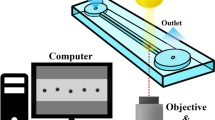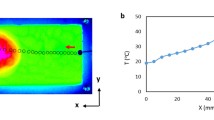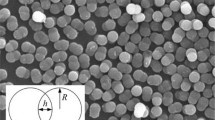Abstract
This work reports an experimental study of the thermal effect on the deposition of microparticles onto a solid surface in a microfluidic system, which allows a precise control of the solution temperature and enables the real-time monitoring of the deposition kinetics at the increased temperature. The static particle deposition rate (Sherwood number) has been measured over a range of temperatures between 20 and 70 °C. It is found that the Sherwood number is monotonically increased up to 265 %, with the solution temperature within the test range. A model including the Derjaguin–Landau–Verwey–Overbeek theory-based colloidal surface forces and gravity force is employed, taking into account temperature effects, to qualitatively interpret the experimental findings. The model shows that, by increasing the solution temperature, the attraction energy (van der Waals force) between the particles and the solid surface is increased while the repulsive energy (electric double layer force) is decreased. These findings demonstrate the importance of thermal effects in various thermally driven deposition processes, such as the fouling of bacteria and milk proteins in microscale milk pasteurization units.









Similar content being viewed by others
References
Adamczyk Z, Warszyński P (1996) Role of electrostatic interactions in particle adsorption. Adv Colloid Interfac 63:41–149. doi:10.1016/0001-8686(95)00281-2
Adamczyk Z, Dabros´ T, Czarnecki J, Van De Ven TGM (1983) Particle transfer to solid surfaces. Adv Colloid Interfac 19(3):183–252. doi:10.1016/0001-8686(83)80001-3
Bansal B, Chen XD (2006) A critical review of milk fouling in heat exchangers. Compr Rev Food Sci Food Saf 5(2):27–33. doi:10.1111/j.1541-4337.2006.tb00080.x
Barisik M, Atalay S, Beskok A, Qian S (2014) Size dependent surface charge properties of silica nanoparticles. J Phys Chem C 118(4):1836–1842. doi:10.1021/jp410536n
Bert R (2001) CRC Materials science and engineering handbook (Book Review). Civil Eng (08857024) 71(8):87
Briscoe WH, Attard P (2002) Counterion-only electrical double layer: a constrained entropy approach. J Chem Phys 117(11):5452–5464. doi:10.1063/1.1500359
Carrera M, Zandomeni RO, Fitzgibbon J, Sagripanti JL (2007) Difference between the spore sizes of Bacillus anthracis and other Bacillus species. J Appl Microbiol 102(2):303–312. doi:10.1111/j.1365-2672.2006.03111.x
Chandra SVJ, Uthanna S, Rao GM (2008) Effect of substrate temperature on the structural, optical and electrical properties of dc magnetron sputtered tantalum oxide films. Appl Surf Sci 254(7):1953–1960. doi:10.1016/j.apsusc.2007.08.005
Chatterjee R, Bhattacharjee S, Mitra SK (2012) Particle transport in patterned cylindrical microchannels. Microfluid Nanofluid 12(1–4):41–51
Chowdhury I, Walker SL (2012) Deposition mechanisms of TiO2 nanoparticles in a parallel plate system. J Colloid Interf Sci 369(1):16–22. doi:10.1016/j.jcis.2011.12.019
Derjaguin BV, Landau EM (1941) Theory of the stability of strongly charged lyophobic sols and of the adhesion of strongly charged particles in solutions of electrolytes. Acta Physicochim 14:633–662
Evenhuis CJ, Guijt RM, Macka M, Marriott PJ, Haddad PR (2006) Variation of zeta-potential with temperature in fused-silica capillaries used for capillary electrophoresis. Electrophoresis 27(3):672–676. doi:10.1002/elps.200500566
Gu Y, Li D (2002) Deposition of spherical particles onto cylindrical solid surfaces: II. Experimental studies. J Colloid Interf Sci 248(2):329–339
Hogg R, Healy TW, Fuerstenau DW (1966) Mutual coagulation of colloidal dispersions. Trans Faraday Soc 62:1638–1651
Hwang G, Ahn IS, Mhin BJ, Kim JY (2012) Adhesion of nano-sized particles to the surface of bacteria: mechanistic study with the extended DLVO theory. Colloids Surf, B 97:138–144
IAPWS (1997a) Release on the refractive index of ordinary water substance as a function of wavelength, temperature and pressure. International Association for the Properties of Water and Steam, Erlangen, Germany
IAPWS (1997b) Release on the static dielectric constant of ordinary water substance for temperatures from 238 K to 873 K and pressure up to 1000 Mpa. International Association for the Properties of Water and Steam, Erlangen
Incropera FP, Dewitt DP (2002) Fundamentals of Heat and Mass Transfer, 5th edn. John Wiley & Sons, New York
Israelachvili JN (1992) Intermolecular and surface forces, 1st edn. Academic Press, Burlington
Kim H-J, Michael Gias EL, Jones MN (1999) The adsorption of cationic liposomes to Staphylococcus aureus biofilms. Colloids Surf, A 149(1–3):561–570. doi:10.1016/S0927-7757(98)00765-1
Kirby BJ, Hasselbrink EF (2004) Zeta potential of microfluidic substrates: 2. Data for polymers. Electrophoresis 25(2):203–213. doi:10.1002/elps.200305755
Kralj-Iglič V, Iglič A (1996) A simple statistical mechanical approach to the free energy of the electric double layer including the excluded volume effect. J Phys II France 6(4):477–491
Kroslak M, Sefcik J, Morbidelli M (2007) Effects of temperature, pH, and salt concentration on β-lactoglobulin deposition kinetics studied by optical waveguide lightmode spectroscopy. Biomacromolecules 8(3):963–970. doi:10.1021/bm060293+
Masliyah JH, Bhattacharjee S (2006) Electrokinetic and colloid transport phenomena. Wiley-Interscience, Hoboken
Mustin B, Stoeber B (2010) Deposition of particles from polydisperse suspensions in microfluidic systems. Microfluid Nanofluid 9(4–5):905–913
Parola A, Piazza R (2004) Particle thermophoresis in liquids. Eur Phys J E 15(3):255–263. doi:10.1140/epje/i2004-10065-5
Perry J, Kandlikar S (2008) Fouling and its mitigation in silicon microchannels used for IC chip cooling. Microfluid Nanofluid 5(3):357–371. doi:10.1007/s10404-007-0254-4
Rajagopalan R, Kim JS (1981) Adsorption of brownian particles in the presence of potential barriers: effect of different modes of double-layer interaction. J Colloid Interf Sci 83(2):428–448. doi:10.1016/0021-9797(81)90339-8
Rodriguez-Santiago V, Fedkin MV, Wesolowski DJ, Rosenqvist J, Lvov SN (2009) Electrophoretic study of the SnO2/aqueous solution interface up to 260 °C. Langmuir 25(14):8101–8110. doi:10.1021/la900611u
Sabirianov RF, Rubinstein A, Namavar F (2011) Enhanced initial protein adsorption on engineered nanostructured cubic zirconia. Phys Chem Chem Phys 13(14):6597–6609. doi:10.1039/C0CP02389B
Scheldeman P, Herman L, Foster S, Heyndrickx M (2006) Bacillus sporothermodurans and other highly heat-resistant spore formers in milk. J Appl Microbiol 101(3):542–555. doi:10.1111/j.1365-2672.2006.02964.x
Sharp K, Adrian R (2005) On flow-blocking particle structures in microtubes. Microfluid Nanofluid 1(4):376–380. doi:10.1007/s10404-005-0043-x
Song L, Elimelech M (1993) Calculation of particle deposition rate under unfavourable particle-surface interactions. J Chem Soc, Faraday Trans 89(18):3443–3452
Song L, Elimelech M (1995) Particle deposition onto a permeable surface in laminar flow. J Colloid Interf Sci 173(1):165–180
Stamm MT, Gudipaty T, Rush C, Jiang L, Zohar Y (2011) Particle aggregation rate in a microchannel due to a dilute suspension flow. Microfluid Nanofluid 11(4):395–403
Suganthi KS, Rajan KS (2012) Temperature induced changes in ZnO–water nanofluid: Zeta potential, size distribution and viscosity profiles. Int J Heat Mass Tran 55(25–26):7969–7980. doi:10.1016/j.ijheatmasstransfer.2012.08.032
Sureda M, Miller A, Diez FJ (2012) In situ particle zeta potential evaluation in electroosmotic flows from time-resolved microPIV measurements. Electrophoresis 33(17):2759–2768. doi:10.1002/elps.201200202
Suzuki A, Ho NFH, Higuchi WI (1969) Predictions of the particle size distribution changes in emulsions and suspensions by digital computation. J Colloid Interf Sci 29(3):552–564. doi:10.1016/0021-9797(69)90140-4
Tuckerman DB, Pease RFW, Guo Z, Hu JE, Yildirim O, Deane G, Wood L (2011) Microchannel heat transfer: early history, commercial applications, and emerging opportunities. ASME Conf Proc 44649:739–756
Unni HN, Yang C (2009) Colloidal particle deposition from electrokinetic flow in a microfluidic channel. Electrophoresis 30(5):732–741
Venditti R, Xuan X, Li D (2006) Experimental characterization of the temperature dependence of zeta potential and its effect on electroosmotic flow velocity in microchannels. Microfluid Nanofluid 2(6):493–499. doi:10.1007/s10404-006-0100-0
Verwey EJW, Overbeek JTG (1948) Theory of the stability of lyophobic colloids. Nature 162:315–316
Wang P, Keller AA (2009) Natural and engineered nano and colloidal transport: role of zeta potential in prediction of particle deposition. Langmuir 25(12):6856–6862. doi:10.1021/la900134f
Würger A (2009) Temperature dependence of the soret motion in colloids. Langmuir 25(12):6696–6701. doi:10.1021/la9001913
Yang C, Dabros T, Li D, Czarnecki J, Masliyah JH (1998) Kinetics of particle transport to a solid surface from an impinging jet under surface and external force fields. J Colloid Interf Sci 208(1):226–240. doi:10.1006/jcis.1998.5806
Zhao Y, Zhao C, He J, Zhou Y, Yang C (2013) Collective effects on thermophoresis of colloids: a microfluidic study within the framework of DLVO theory. Soft Matter 9(32):7726–7734. doi:10.1039/C3SM27720H
Acknowledgments
Zhibin Yan gratefully acknowledges the research scholarship from Nanyang Technological University, Singapore.
Author information
Authors and Affiliations
Corresponding author
Appendix
Appendix
It is known that the process of particle deposition from liquid media onto a solid surface consists of two sequential steps: transport and attachment. Gravity can influence the transport of particles from bulk suspension to the surface, while the mass diffusion of particles is another important factor in the absence of hydrodynamic flow as the case considered in this study. The final attachment onto surfaces (deposition) is mainly determined by colloidal forces (van der Waals force and electric double layer force) in the near-wall region.
In order to confirm whether gravity plays a dominant role or not in the enhanced particle deposition at elevated temperatures, we designed and conducted another set of experiments for the particle deposition on the top surface (upper wall) of the deposition channel. As shown in Fig. 10a, the experimental setup is similar to the one presented in the main text, but a new microchip consists of a smooth top plate (PMMA) and a grooved bottom plate (PMMA) with the deposition channel and heating channels as illustrated by Fig. 10b. Besides, an upright microscope (Zeiss) is used to facilitate the observation of particle deposition on the top surface. The tested sample contains the same particle volumetric number concentration (5.6 × 106/ml) as that in the previous experiments in a 5 × 10−5 M NaCl electrolyte solution. The geometric dimensions of the channels and other experimental conditions and procedures are maintained as the same as those in previous experiments of the particle deposition onto the bottom surface presented in the main text.
Figure 11 shows that the dimensionless average particle deposition flux onto the top surface, Sherwood number, is monotonically increased with increasing the solution temperature. The Sherwood number is increased about 8 times, from 0.00022 to 0.00194, when the temperature of sample solution is increased from room temperature to 339.25 K. In Fig. 11, the dotted straight line presents the maximum possible deposition rate onto the top surface at various elevated temperatures if the increased gravity plays a dominant role in the deposition process. Since the gravity points downward, particles would be pulled away from the top surface and thus be prevented from deposition onto the top surface. However, the measured particle deposition rates versus elevated temperatures are much higher than such assumed maximum value. This suggests that the increased particle deposition at elevated temperatures is mainly dominated by the colloidal surfaces instead of gravity force. More specifically, the energy barrier and the competition between the electric double layer and the van der Waals force interactions significantly affect the deposition rate on the top surface. As we proposed in the main text, with increasing solution temperature the attractive potential (van der Walls interaction) is increased while the repulsive potential (electric double layer interaction) is reduced. Consequently, the energy barrier is decreased by increasing solution temperature. As a result, particles in the near-wall region have higher chances to overcome the barrier and deposit onto the surface.
Dimensionless deposition rate (Sherwood number) onto the top surface of the channel at five different solution temperatures, 297.25, 317.35, 324.85, 331.85 and 339.25 K. The dotted line indicates the maximum deposition rate at elevated temperatures if the increased gravity plays a dominant role in the deposition process
Therefore, the experimental results presented in both the main text and the appendix suggest that gravity may affect the particle transport process, but it is the colloidal forces that determine the deposition at the attachment step. The enhanced particle deposition on the bottom wall at elevated temperature reported in this study is mainly attributed to the variation of colloidal forces in the near-wall region while the increased gravity facilitates the transport of particles from bulk suspension to the surface.
Furthermore, we plotted the electric double layer (EDL) interaction potential, the van der Waals (vdW) interaction potential and the gravity potential versus particle–surface separation distance by using the modified DLVO-based model with consideration of gravity at a solution temperature of 343.15 K, and the results are shown in Fig. 12. It can be seen clearly that the gravity effect is considerable at long range where the transport of particles occurs, but it becomes negligible when particles approach to the vicinity of the surface where the attachment happens.
Dimensionless EDL, vdW and gravity interaction potential as a function of separation distance (T = 343.15 K). Curves are obtained with temperature-dependent water density, Hamaker constant, zeta potential and thickness of electric double layer. Inset shows the gravity plays a role at long range but becomes negligible in the near-wall region
In addition, the following provides a scaling analysis for the particle thermal energy versus the applied thermal energy. Given a particle, both the particle thermal energy, E particle , and the applied thermal energy, E applied , can be calculated from Eqs. (22) and (23), respectively.
where N p is the number of molecules contained in the particle, k is the Boltzmann constant (1.38 × 10−23 J/K), T is the solution temperature, T 0 is the reference temperature (293.15 K), and c p is the specific heat of polystyrene particle, and its value is about 1.3 J/g·k, and m p is the mass of particle. Furthermore, the number of molecules contained in one particle can be obtained from
where N A is the Avogadro constant, M w is the molecular weight of polystyrene particle and its value is 10,400 g.
Therefore, the ratio of E applied to E particle is given by
Table 2 summarizes the estimated ratio of the applied thermal energy to the particle thermal energy at various elevated temperatures, and the results show that the applied energy by heating is significant compared to the particle thermal energy.
Rights and permissions
About this article
Cite this article
Yan, Z., Huang, X. & Yang, C. Deposition of colloidal particles in a microchannel at elevated temperatures. Microfluid Nanofluid 18, 403–414 (2015). https://doi.org/10.1007/s10404-014-1448-1
Received:
Accepted:
Published:
Issue Date:
DOI: https://doi.org/10.1007/s10404-014-1448-1







